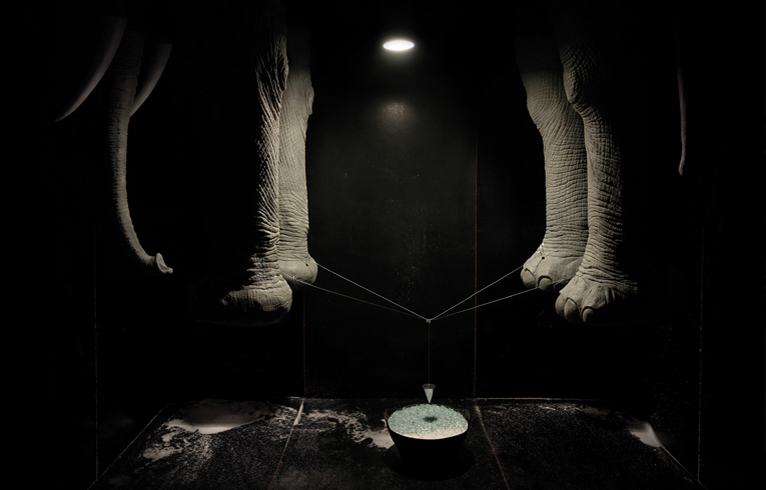GAO LEI: THE PRINCIPLE
| December 23, 2011 | Post In LEAP 11

Elephants drop through the ceiling, dogs poke their heads through pipes, and parrots perch on upside-down human statuary. Gao Lei’s mixed-media installations draw on a bestiary to examine human ambition and human limits. His art is populated by a carnival of animals that appear in room-sized installations, photographs enclosed inside lightboxes, and mixed-media oil paintings, where clean, light, precise applications of paint evoke a naturalist’s sketchbook. In one such painting from 2009, titled A109, a goat takes on the quality of myth. Pale and white, anthropomorphic and spiritual, it bows its head as if it has just emerged from a medieval fairy tale. Using its horns as a compass, the animal effectively makes its own halo. These religious, mythical and scientific references collide with the detritus of contemporary life— a closed-circuit TV camera, for instance, is attached to the ceiling above. Al09 does not transport us to any specific historical time or place, but parachutes us down into the provinces of the artist’s imagination.
These imaginary provinces— Gao Lei’s own private universe— are grounded in real-world issues. His animals and, when they appear, his humans, are physically connected to machinery. His vision is tragic, if not fatalistic. He sometimes employs a repertoire of classical myth— like the flight of Icarus— as material for his artistic practice. His mixed-media drawings Room 0901 and Room 0902 work as a suite. In Room 0901, a naked man— executed in ballpoint pen on canvas— faces away from the viewer, held aloft in suspended flight. The artist has not adorned the man with angelic wings. Instead, he has screwed metallic bicycle brake-handles onto the man’s shoulders, acting at once as that which elevates him through space and, as that which restrains him. Room 0902 echoes this theme. A crane, also drawn in ballpoint pen, extends its wings, but it can’t fly, at least not without a struggle. The artist has strapped a single red string, held taut by two screws, across the length of its wingspan. Man and bird are imprisoned in separate rooms (and in separate frames of the canvas), but for both, the wings that would grant them flight have been put in check, customized to fall as much as they are to fly.
Gao Lei’s central questions are related to power and the information it carries. Who restrains our wings? Who places us in these rooms? Who is transmitting the messages that repress our ability to fly? In the large-scale installation A305, we peer into the interior of a room-sized wooden box— what the artist calls a “super power structure”— at an elephant. The elephant has fallen through the ceiling, but remains suspended above the floor. An industrial fan blows silicon fluff around the room’s interior while the elephant’s legs sway in the gale, movement that is restricted by a pendulum that swings from its four legs. Is the pendulum used as a monitoring device or as a restoring force? Is this power structure inherent in the nature of the universe or is some human agent shoving power-structure propaganda down our gullets? Is it designed by the gods or by the master bastards of realpolitik? Gao never answers these questions for us, but not because they are unanswerable. To answer them could lead to an even harsher sentence. Aren’t questions, after all, the true angels of motion? To voice them— if not openly in the chamber, then at least tacitly in the heart— might be the only freedom we have.
Stacey Duff


